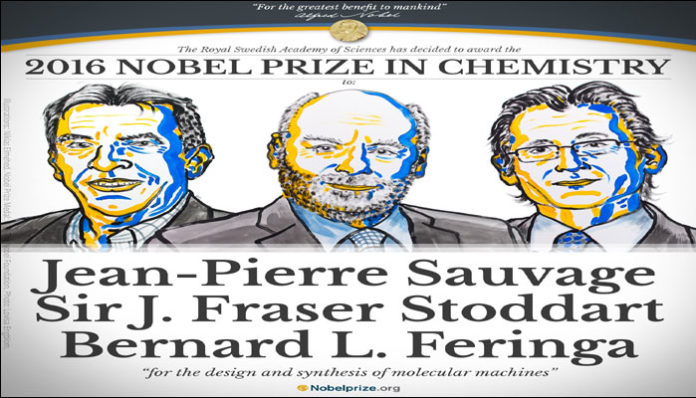The Nobel Prize in Chemistry for 2016 has been awarded to Jean-Pierre Sauvage, Sir J. Fraser Stoddart and Bernard L. Feringa for developing molecular machines.
About Nobel in Chemistry :
The Nobel Prize in Chemistry is awarded annually by the Royal Swedish Academy of Sciences to scientists in the various fields of chemistry. It is one of the five Nobel Prizes established by the will of Alfred Nobel in 1895, awarded for outstanding contributions in chemistry, physics, literature, peace, and physiology or medicine.
- This award is administered by the Nobel Foundation and awarded by Royal Swedish Academy of Sciences on proposal of the Nobel Committee for Chemistry which consists of five members elected by Academy.
- The award is presented in Stockholm at an annual ceremony on December 10, theanniversary of Nobel’s death.
- The first Nobel Prize in Chemistry was awarded in 1901 to Jacobus Henricus van ‘t Hoff, of the Netherlands, for his discovery of the laws of chemical dynamics and osmotic pressure in solutions.
About Jean – Pierre Suavage :
Jean-Pierre Sauvage(born October 21, 1944) is a French coordination chemist working at Strasbourg University. He has specialized in supramolecular chemistry for which he has been awarded the 2016 Nobel Prize in Chemistry along with Sir Fraser Stoddart and Bernard L. Feringa.
- Sauvage was born in Paris in October 21, 1944 and obtained his Ph.D. from the Université Louis-Pasteur under the supervision of -M. Lehn. During his PhD work, he contributed to the first syntheses of the cryptand ligands. After postdoctoral research with M. L. H. Green, he returned to Strasbourg, where he is now emeritus professor.
- A prolific scientist, he has worked in several areas including electrochemical reduction of CO2and models of the photosyntheti creaction center. A large theme of his work is molecular topology, specifically mechanically-interlocked molecular architectures. He has described syntheses of catenanes and molecular knots based on coordination complexes.
- He was elected a correspondent member of the French Academy of Sciences on March 26,
 1990, and a member on November 24, 1997. He is currently emeritus professor at the University of Strasbourg (Unistra).
1990, and a member on November 24, 1997. He is currently emeritus professor at the University of Strasbourg (Unistra).
About Sir J. Fraser Stoddart :
Sir James Fraser Stoddart is a Scottish chemist currently (as of 22 March 2014) at the Department of Chemistry at Northwestern University in the United States.
- He works in the area of supramolecular chemistry and nanotechnology. Stoddart has developed highly efficient syntheses of mechanically-interlocked molecular architectures such as molecular Borromean rings, catenanes and rotaxanes utilizing molecular recognition and molecular self-assembly
- He has demonstrated that these topologies can be employed as molecular switches and as motor-molecules.His group has even applied these structures in the fabrication of nanoelectronic devices and nano electromechanical systems (NEMS).
- His efforts have been recognized by numerous awards including the 2007 King Faisal International Prize in Science. He shared the Nobel Prize in Chemistry together with Ben Feringa and Jean-Pierre Sauvage in 2016 for the design and synthesis of molecular machines.
About Bernard L. Feringa :
Bernard Lucas “Ben” Feringa is asynthetic organic chemist, specializing in molecular nanotechnology and homogenous catalysis.
- He is theJacobus Van’t Hoff Distinguished Professor of Molecular Sciences, at the Strating Institute for Chemistry, University of Groningen, Netherlands, and an Academy Professor and Chair of Board of the Science Division of the Royal Netherlands Academy of Sciences.
- He received the 2016 Nobel Prize in Chemistry, together with Sir J. Fraser Stoddart and Jean-Pierre Sauvage, “for the design and synthesis of molecular machines“.
- Feringa’s research achievements range from fundamental contributions in modern stereochemistry and chirality to the rapidly developing field of molecular nanotechnology and dynamic molecular systems with seminal contributions to organic synthesis, asymmetric catalysis, molecular recognition and self-assembly.
- Probably the most widely known work that Feringa has performed involves molecular switches and motors, which have been centered on stereo chemistry, asymmetric catalysis and dynamic molecular systems. His team at the University of Groningen has pioneered the control and use of dynamic functions and molecular motion.



 1990, and a member on November 24, 1997. He is currently emeritus professor at the University of Strasbourg (Unistra).
1990, and a member on November 24, 1997. He is currently emeritus professor at the University of Strasbourg (Unistra).

